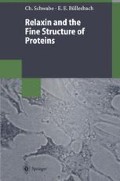Abstract
Rat relaxin had been known for about 18 years and had been thoroughly characterized mainly through by Sherwood et al.1–4 The relaxin used in those studies had been isolated by the method of Walsh et al in which homogenized ovaries were extracted with a mixture of trifluoroacetic acid (15%), formic acid (5%), sodium chloride (1%) and hydrochloric acid (1M).5,6 The conditions seemed rather rough but an active hormone was obtained which was used for all subsequent studies until very recently. Rat relaxin (Fig.13.1), always considered to be a relaxin of low potency, made a natural connection to our structure function studies, in particular the beneficial effect of replacement of histidine B10 in insulaxin for a glutamic acid. In the rat this position was occupied by glycine and based on a central dogma in protein chemistry, this was an unfavorable situation. Glycine is considered a helix-breaking residue and its presence in the major B chain helix right at the receptor interaction site seemed a clear indication that glycine B14 was compromising the bioactivity of rat relaxin. The opportunity was irresistible to test one’s ability to predict how certain features in a molecule would influence its bioactivity and subsequently to improve on a natural product. First rat relaxin was needed to establish a baseline and consequently a few milligrams were synthesized by the new method.7
Access this chapter
Tax calculation will be finalised at checkout
Purchases are for personal use only
Preview
Unable to display preview. Download preview PDF.
References
Sherwood OD. Purification and characterization of rat relaxin. Endocrinology 1979; 104: 886–892.
Lao Guico-Lamm M, Sherwood OD. Monoclonal antibodies specific for rat relaxin: II passive immunization with monoclonal antibodies throughout the second half of pregnancy disrupts birth in intact rats. Endocrinology 1988; 123: 2479–2485.
Kuenzi MJ, Sherwood OD. Monoclonal antibodies specific for rat relaxin: VII passive immunization with monoclonal antibodies throughout the second half of pregnancy prevents development of normal mammary nipple morphology and function in rats. Endocrinology 1992; 131: 1841–1847.
Sherwood OD. Relaxin. In: Knobil E, Neill JD, eds. Physiology of Reproduction. Vol I. 2nd ed. New York: Raven Press, 1994861-IOmo.
Walsh JR, Niall HD. Use of an octadecylsilica purification method minimizes proteolysis during isolation of porcine and rat relaxin. Endocrinology 1980; 107: 1258–1260.
John M, Borjesson BW, Walsh JR et al. Limited sequence homology between porcine and rat relaxins: Implication for physiological studies. Endocrinology 1981; 108: 726–729.
Büllesbach EE, Schwabe C. The chemical synthesis of rat relaxin and the unexpectedly high potency of the synthetic hormone in the mouse. Eur J Biochem 1996; 241: 533–537.
DeGrado WF, Wasserman ZR, Lear JD. Protein design, a minimalist approach. Science 1989; 243: 622–628.
Hecht MH, Richardson JS, Richardson DC et al. De Novo design, expression, and characterization of Felix: A four-helix bundle protein of native-like sequence. Science 1990; 249: 884–891.
Mattos C, Ringe D. Locating and characterizing binding sites on proteins [Review]. Nature Biotechnology 1996; 14: 595–599.
Author information
Authors and Affiliations
Rights and permissions
Copyright information
© 1998 Springer-Verlag Berlin Heidelberg
About this chapter
Cite this chapter
Schwabe, C., Büllesbach, E.E. (1998). A Surprising Message from Murines. In: Relaxin and the Fine Structure of Proteins. Springer, Berlin, Heidelberg. https://doi.org/10.1007/978-3-662-12909-8_13
Download citation
DOI: https://doi.org/10.1007/978-3-662-12909-8_13
Publisher Name: Springer, Berlin, Heidelberg
Print ISBN: 978-3-662-12911-1
Online ISBN: 978-3-662-12909-8
eBook Packages: Springer Book Archive

